Bee Balm: How To Grow And Care For Monarda
We all want to encourage pollinators to populate our gardens. After all, without those pollinating insects, we don't have flowers or produce! And so, to draw beneficial insects to our yards, we tend to use plants like bee balm.
But what is bee balm, exactly? It's a part of the mint family (Lamiaceae), and an awful lot of people grow it... does that mean it's a mint? Does it do anything more than just look pretty? Are there different types of bee balm, and if so, what are the differences?
Today, we'll go over some of the Monarda species of plants, and examine the differences between these different types of bee balm. We'll discuss how to care for both the annual and perennial varieties of the plants, how to propagate new ones, and talk about the historical uses of these plants. So let's dive in and learn all there is to learn about bee balm!
Bee Balm Overview
| Common Name(s) | Bee balm, eastern beebalm, Bradbury’s beebalm, lemon beebalm. lemon mint, purple horsemint, lemon horsemint, basil beebalm, crimson beebalm, scarlet beebalm, scarlet monarda, Oswego tea, bergamot, wild bergamot, purple bergamot, spotted beebalm, horsemint |
| Scientific Name | Many members of the Monarda plant family, including Monarda bradburiana, Monarda citriodora, Monarda clinopodioides, Monarda didyma, Monarda fistulosa, Monarda media, Monarda punctata and others |
| Family | Lamiaceae |
| Origin | United States |
| Height | 12-36” depending on species |
| Light | Full sun to afternoon part shade |
| Water | Moderate, but is drought-tolerant |
| Temperature | Annuals prefer 45 degree and up, perennials can overwinter |
| Humidity | Average |
| Soil | Average to rich |
| Fertilizer | Compost or all-purpose plant fertilizer (slow-release or liquid) |
| Propagation | Division, cuttings, or seeds |
| Pests | Stalk borers, spider mites, thrips. Also is susceptible to powdery mildew and root rot in the right conditions. |
Types of Bee Balm
There are many different varieties of the Monarda species, and about 50 commercial cultivars commonly available. But an awful lot of bee balm varieties are naturally-growing wildflowers in the United States. Let's look at a short list of some of the types of bee balm and the differences between them.Monarda bradburiana, 'Eastern beebalm', 'Bradbury's beebalm'
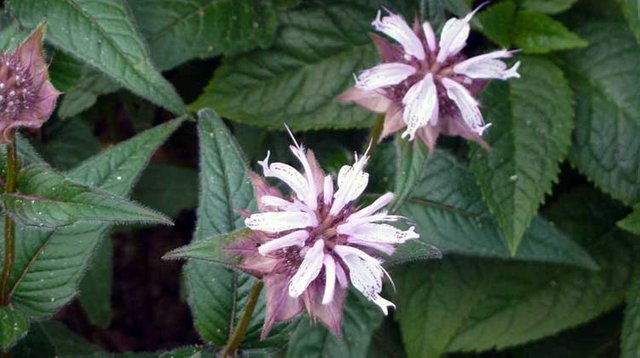
This perennial bee balm has a lower cushion of rich green foliage, with lightly-toothed edges along oval leaves. Rising above, the flower stems tinge towards purple, and culminate in a lavender to light purple flower. The flowers produce large amounts of nectar, which draws a variety of wildlife from bumblebees to hummingbirds. It's native to the central and southeast United States.
Monarda citriodora, 'Lemon beebalm', 'Lemon mint', 'Purple horsemint', 'Lemon horsemint'
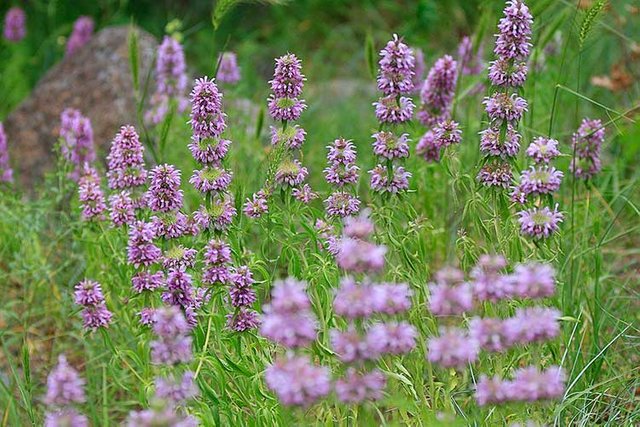
An annual, lemon bee balm is often found as a wildflower in much of the United States and into Mexico, but is also widely cultivated. This monarda does not look anything like Bradbury's, in that it has long spear-like or grassy leaves and a much more compact plant base. The stem rises from the center of the plant and has multiple purple or purplish-pink florets stacked atop it.
The lemon part of its name refers to the lemony scent that new leaves have when crushed, caused by naturally-forming citronellol, and it's commonly used as an insect repellent in gardens because of that aroma. However, it should not be confused with the other plant commonly known as "lemon mint", despite sharing the name.
Monarda clinopodioides, 'Basil beebalm'
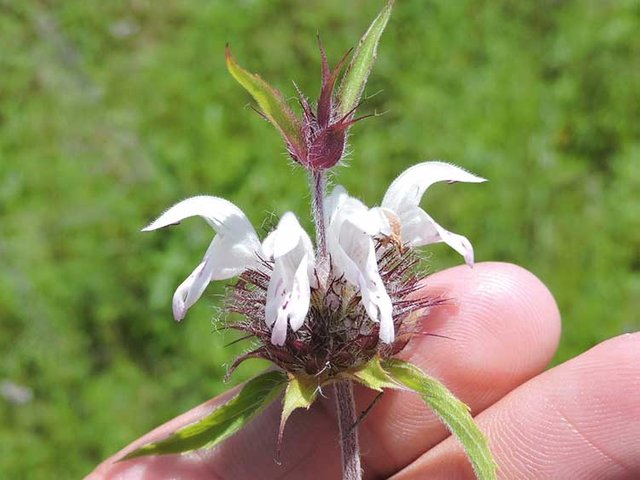
The annual known as basil bee balm is a native of Kansas, Oklahoma, Texas and Louisiana. This plant is a bit woody, with long slender leaves on the flower stalks mixed with slightly oblong leaves at the plant's base. The flower stalk supports multiple florets of pale purple bee balm flowers stacked neatly in a conical form.
Monarda didyma, 'Crimson beebalm', 'Scarlet beebalm', 'Scarlet monarda', 'Oswego tea', 'Bergamot'
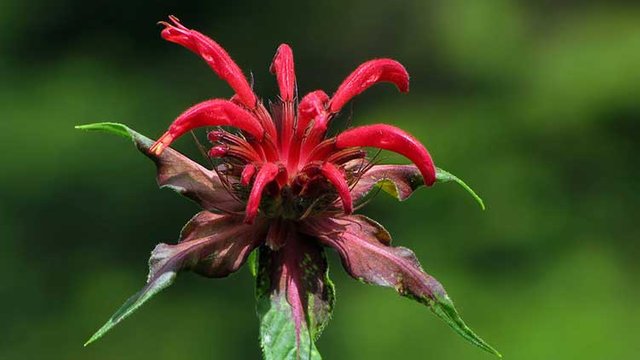
This popular ornamental plant is a perennial. Native to the eastern United States, it is widely naturalized throughout the rest of the US and in parts of Europe and Asia. Showy tubular flowers in inflorescences of about 30 around a central bract rest at the tip of a vibrant green stem, surrounded by lush green leaves. There are many different cultivars which produce bee balm colors of medium to dark red, white, purple and pink flowers. But the term bergamot is misleading, as no monarda is a true "bergamot" of the type used to scent teas.
Monarda fistulosa, 'Wild bergamot', 'Bee balm'
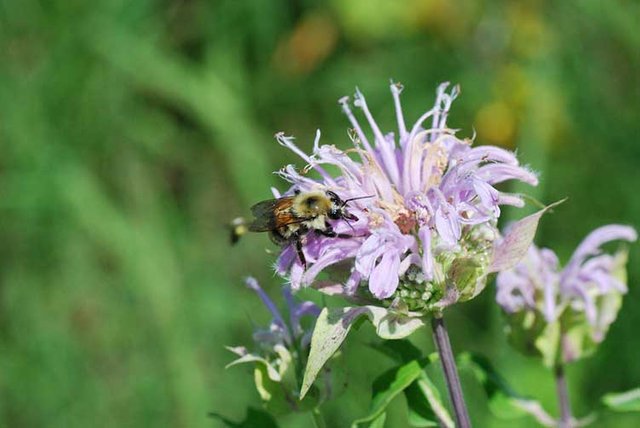
A wild perennial, the wild bergamot produces showy lavender or pink blossoms throughout the summer months. Each flower cluster on its branch can produce between 20-50 flowers, and rests over brilliant green herbaceous foliage. There are multiple varieties of this plant, many of which have slightly different odors. In fact, Native American tribal people recognized at least four separate variations for their scents, each indicating different uses for the plant.
Monarda media, 'Purple bergamot'
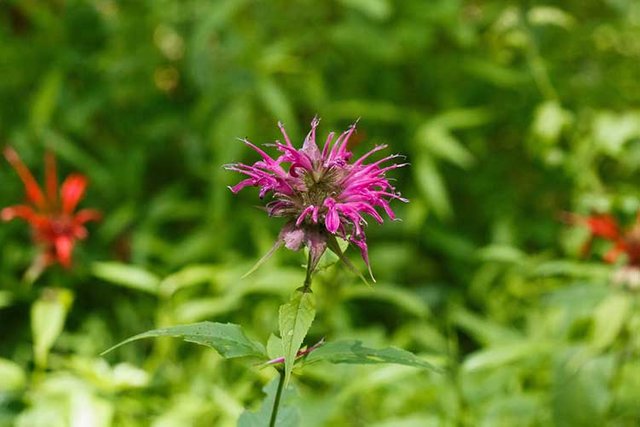
Typically found in swampier environments such as riverbeds, this perennial has lance-shaped leaves and square stalks. At the top of the stalk forms a large inflorescence in a reddish-purple hue, made up of many smaller flowers around a seed head. While it is not a true bergamot any more than Monarda fistulosa or Mondarda didyma, it has a similar aroma to the bergamot orange used for scenting commercial teas. It is common throughout the eastern United States and into Canada.
Monarda punctata, 'Spotted beebalm', 'Horsemint'
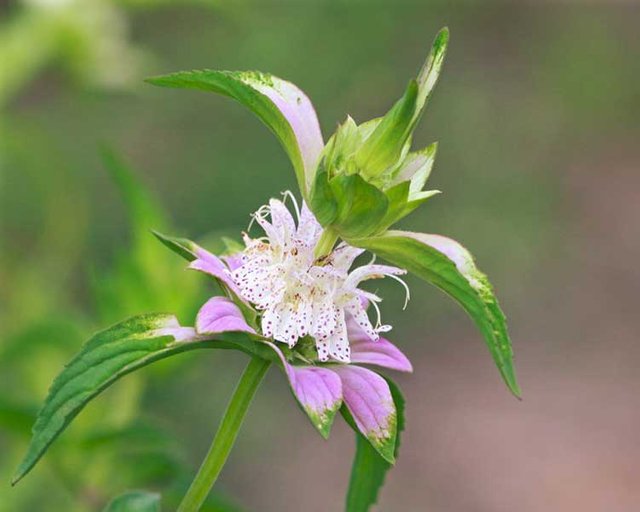
The spotted bee balm can be either an annual or a perennial depending on its environment. It seems to favor sandy soils with good drainage. The flower heads are stacks of flowers, each with its own bract, and are yellow with purple spots and occasionally purple petal-tips. The foliage is slender-leaved and bright green in hue. Monarda punctata is a major draw for beneficial insects, especially beneficial predatory wasps. It has a thyme-like aroma.
Bee Balm Care
Growing beebalm is generally quite simple, as it's a very forgiving plant. When trying to decide how to grow bee balm, you will want to pick a good location with ample light, well-draining soil, and if you're growing it to encourage beneficial insects or hummingbirds to visit your yard to pollinate or to help wipe out pests, you'll want to place it near your food plants. But let's look a little closer at what the optimal conditions to grow bee balm are.
Light
In much of the United States, you can plant bee balm in full sun to promote blooming. In hotter areas of the south or southwestern US, a little afternoon shade will help the flowering season to last a bit longer and will protect the perennial varieties from the scorching heat of the afternoon.
Water
Most bee balm varieties are reasonably drought-tolerant, but they do much better with regular watering. Keeping the soil damp but not wet should be adequate. Be sure that the area your bee balm is planted in does not get soggy during the winter months and stays well-draining so you do not drown your perennial varieties! An exception to this is Monarda media, which likes more moisture, but even then it does need room for the roots to breathe as well.
Soil
Monardas don't always like overly wet soil, so it's important that your soil is able to drain off any excess water. The wild forms of bee balm are not at all picky in terms of soil fertility, and are known to grow in anything from sandy soils to potting mix. Commercial cultivars like slightly richer soil, likely because of years of propagation in better quality soils. The pH of your soil should ideally range between 6.0 and 6.7 for best growth, and I like to add some compost to the bed to give the soil extra nutrient value before planting.
Fertilizer
There are two common methodologies for fertilizing bee balm.
A nice layer of top-dressed compost in the spring followed by a couple inches of mulch will offer plenty of plant nutrition along with some weed prevention.
Alternately, you can use a general-purpose fertilizer, either a slow-release granular form dug into the soil or a liquid formula. Either of these options should keep your bee balm well-fed.
Repotting
Bee balm often forms a rather dense root ball in pots. When repotting, it is often a good idea to divide the plant to ensure that it doesn't get too rootbound. Start out by loosening the soil around the roots, and then gently working a shovel beneath the root ball. Pry it upward carefully until you can free the plant from its pot.
If you are going to divide the plant, shake it gently and brush off as much loose soil as possible without harming the plant. Once you're able to see the individual roots, cut through the thicker roots with a pair of pruning shears, and then gently pry the two segments apart to maintain the smaller roots. You want to make certain that every division has plenty of root mass to regrow from.
When you have the plants divided down to the size you desire, inspect the roots, trimming off any which appear slimy or partially-rotten. Similarly, trim off any weak or broken stems from the plant. Work quickly so that the roots do not dry out, and immediately replant in new pots or garden beds once you've got your plants prepared.
Propagation
While you can propagate your bee balm by division as mentioned above in the repotting segment, it can also be grown from cuttings or from seeds.
If propagating from cuttings, select new spring growth from the tips of the stems, cutting them at least six inches long and just below a set of leaves. Place your cuttings into a small pot which is filled with perlite, peat moss, vermiculite, or a blend of any of these options. Water them well and set them inside a plastic bag to help retain some moisture. Once they have taken root, remove the plastic bag and repot your cuttings in potting soil and place in a sunny window or greenhouse until you are ready to replant elsewhere.
If you are growing from seed, first make sure your seed is not from a hybrid cultivar, as they often do not breed true. Plant your seeds in the very early spring when the soil is still cool and there is still a chance of light frost. When your seedling plants have formed at least two sets of true leaves, you can then thin them down to 18-24" apart or transplant them to space them out as needed.
You can save seeds from your plants, although if it's a hybrid, it likely will not breed true. Generally, the seeds are ready for harvest one to three weeks after the flowers have bloomed. Carefully place a paper bag at the base of your plant, and then gently bend a stalk over the bag and tap it. If brown seeds fall into the bag, the seed is ready to be collected. Allow the seeds to dry on paper towels in a well-aerated environment for 3-4 days and then place them in an airtight sealed container in the refrigerator until ready to plant them.
Pruning
In the early spring, if you have established bee balm, it's good to pinch back their growth when they reach about 12" tall to encourage lateral spreading. All you have to do is gently pinch off the top set of leaves from each stem. The plant will naturally spread wider before flowering.
If you'd like to encourage a longer floral display, stagger out that early pinching over a few weeks. Do about a third of your plants the first week, another third the second, and finally the remainder on the third week. Be sure to spread out the process over your whole garden so that you have even bloom distribution later.
If you have a large area of bee balm, you can opt to simply prune the entire patch at once with a pair of hand clippers or shears. Once it reaches the 12" height, you can just evenly trim it to about half its height, which encourages lateral growth as well as more leaf mass. Doing this should discourage your plants from going lanky or weedy in appearance.
As your flowers start to fade, you should deadhead bee balm just above the next flower bud to encourage further flowering. Once a stem has finished flowering, trim it back down to the ground or pinch it off. This will encourage the plant to send up another blossoming stem.
In the fall or winter, you should prune bee balm after it has died back. Take it back down to just above the soil's surface. This allows you to clean up the dead plant material, and perennial varieties will begin to show signs of new growth in the late winter or early spring again.
Problems
There are very few problems in growing bee balm. Realistically, it is an incredibly forgiving plant, and it will tolerate a wide variety of situations, soil conditions, sunlight conditions, and weather. However, it is susceptible to a few pests and diseases.Pests
Bee balm can be susceptible to stalk borers, spider mites, and thrips.Stalk borers do exactly what their name implies, as the larvae tunnel into the stalk of the plant. If you see a small hole with a yellowish edge in the stem of your bee balm, cut the stalk at least an inch below the hole, and check inside the removed stalk to see if the larva is inside. If it is, destroy that stalk. If the plant begins to wilt before you have caught the stalk borer and removed it, it is likely going to die.
Spider mites cause yellowish spots on leaves by sucking out the plant juices. There will also be super-fine webbing on the plants themselves. To combat these, use insecticidal soaps or horticultural oils like neem oil to eliminate the spider mites.
Thrips do similar damage to what spider mites inflict, except they do not build webbing on the plant surfaces. Neem oil and spinosad can reduce the population significantly.
Diseases
Bee balm is susceptible to powdery mildew. While it's not always fatal to the plant, it blocks the plant's ability to take in the sun's rays and do photosynthesis, so it is best to treat it whenever possible. Allow for good air circulation around your plants, especially if you live in a more humid environment. If necessary, regular applications of neem oil can wipe out powdery mildew.
During the colder months of the year, bee balm can be susceptible to root rot if the soil where it's planted is not well draining. To avoid this, ensure the soil is very well draining beneath your plant. Root rot is not something which can be treated, so be sure to avoid it!
Frequently Asked Questions
Q: Is bee balm edible?
A: The vast majority of bee balm species can be eaten, yes. Portions of the plant above-ground are edible, and the leaves are often used as a flavoring in cooking, although it may be bitter if used in too large of a quantity. It is often used to season poultry or game fowl. The flower petals make a beautiful edible addition to salads.
Q: Can bee balm be used medicinally?
A: Many Native American tribes and early settlers to the United States used bee balm medicinally. The Monarda species contains naturally-forming thymol, which is an antiseptic that's often used in commercial mouthwashes. This made it quite useful as a poultice on injuries as well as for dental care purposes. It has also been used to help remedy stomach ailments and flatulence, among other things. In addition, the subspecies Monarda citriodora has naturally forming citronellol, allowing it to be used as an insect repellent by rubbing the bruised leaves onto one's skin.
Q: Is bee balm an invasive plant species?
A: If you don't contain it... yes! Bee balm is still a relative of mint, and has all the same runner-like properties that mint has. So if you don't keep it reduced in size, it will gradually spread to take over the space that you have available. Divide off the plant regularly to keep it manageable, keep the runners trimmed, and it won't take over your entire garden.
Q: What companion plants grow well with bee balm?
A: If you'd like to lure hummingbirds or beneficial insects to your yard, planting Western columbine or silver sage with your Monarda will help! When mixed with Joe Pye weed, bee balm can be a surefire lure for butterflies, too. If you're looking to add color to your herb garden, plant the bee balm towards the center or rear of your garden space, as they will be taller than most annual herbs, and try growing thyme, basil, parsley, or chives around it. For a burst of added color against the purple or redder colors of bee balm, try growing daylilies for a bright yellow, or select a nicely contrasting blue by planting agapanthus. And finally, for nice blends of similar-sized plants, growing black-eyed Susans or echinaceas nearby can make your blooms similar in height, but if you want a lower flower beneath these, try a dwarf phlox along the base to add a spark of brightness beneath the larger blossoms.
Hopefully, you'll consider this wonderful and easy-to-care-for plant as a future addition to your garden, as it'll draw all sorts of wonderful pollinators and beneficial insects, butterflies and hummingbirds to your yard! Have you ever grown bee balm, and if so, what's your favorite variety or hybrid? Let me know!
Thanks For Reading!
If this is your first time reading my writing, thank you!
My name is Kevin and I run a website called Epic Gardening, where it is my goal to teach 1,000,000 people how to garden. This post will go live on my site on October 9 at 9am PST. I put it on Steemit first :).
Now that I've found Steemit, I'm going all in on this community and sharing as much as I can here. You'll find me writing about gardening, business, health, and philosophy - I can't seem to stick to one topic :P
Thanks and happy Steeming,

Kevin
**@halcyondaze got you a $6.7 @minnowbooster upgoat, nice!
Want a boost? Minnowbooster's got your back!
The @OriginalWorks bot has determined this post by @halcyondaze to be original material and upvoted it!
To call @OriginalWorks, simply reply to any post with @originalworks or !originalworks in your message!
To enter this post into the daily RESTEEM contest, upvote this comment! The user with the most upvotes on their @OriginalWorks comment will win!
For more information, Click Here! || Click here to participate in the @OriginalWorks writing contest!
Special thanks to @reggaemuffin for being a supporter! Vote him as a witness to help make Steemit a better place!
@reported has voted on behalf of @minnowpond. If you would like to recieve upvotes from minnowpond on all your posts, simply FOLLOW @minnowpond. To be Resteemed to 4k+ followers and upvoted heavier send 0.25SBD to @minnowpond with your posts url as the memo
I love bee balm and am trying to decide where I can plant it and let it take over!
I'm putting in some as we speak! We're twins
this would be a wonderful addition to any herb or vegetable garden. Not only for its beauty and colorful flowers but as a pollinator.
Thanks for introducing me to it! I had heard of it before but never given it too much thought. You have changed that!